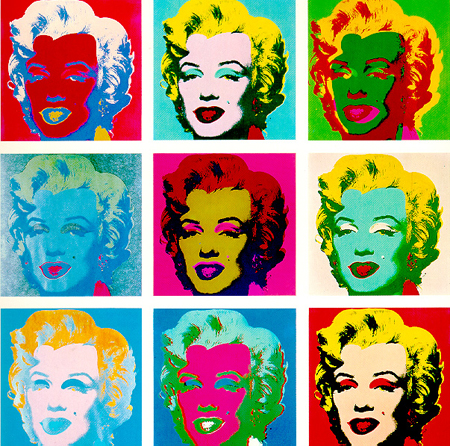Serendip is an independent site partnering with faculty at multiple colleges and universities around the world. Happy exploring!
Presentation


Isn't life just a series of images that change as they repeat themselves?
-Andy Warhol
For me, the Warhol quote that appears above is one that I’ve always believed could be applied not only to life, but also to any film, and now to graphic novels. In “Metropolis,” many of the images were, as Anne said in class, stylized, and the same held true for Persepolis. The stylization of the images, I thought, highlighted their “changing as they repeat themselves.”

This panel of Persepolis, “The Veil,” is one such image. The girls wearing veils in the first column are the same girls as in the picture at the bottom of the page. The image of the girls is repeating itself, but it is changing at the same time and showing the difference between the girls’ behavior with their veils as opposed to without.
Another set of images like the ones from “The Veil” that made me think of this Warhol quote were a couple of images from the silent film “Metropolis” that Anne suggested to the class.

This first image from “Metropolis” is one of the shift change at the factory where all of the lower-class people work. The film portrays the people who work at the factory as identical and very replaceable.

While the first image expresses the concept of the replaceable worker adequately, this second image of the Moloch takes the replaceable sentiment to a completely different level. In the scene with the Moloch, the machine on which all the workers work malfunctions, and the workers who messed up the machine are, in effect, eaten by it. In the image, the workers who have been disposed of are gone already, and new workers are being brought up to replace them.
Although I used to dislike graphic novels, Persepolis changed my mind about the genre. It taught me to pay attention to the conglomeration of words AND images instead of just one or the other. This also made me think of the meshing of genres between graphic novels and films as a whole. “Metropolis” was very far removed from Persepolis as far as plot went, but the way each was presented was similar. “Metropolis” and Persepolis could easily fit into the same genre for presentation, but not for story.
This made me wonder: is genre just a matter of presentation?
Works Cited:
"Metropolis Drones"-http://boxoffice.com/blogs/steve/metropolis_drones.jpg
"The Moloch"-http://rassionmagazine.files.wordpress.com/2010/02/lang_metropolis_moloch_2_stor.png
"Marilyn"-http://www.genetologisch-onderzoek.nl/wp-content/image_upload/andy-warhol-marilyn.jpg
Warhol quote-http://thinkexist.com/quotation/isn-t_life_a_series_of_images_that_change_as_they/324350.html
"The Veil"-http://www.rand.org/international_programs/cmepp/imey/images/persepolis-page.gif



Comments
"Just a series of images that change as they repeat themselves"
Molly--

I'd been so tickled w/ my revelation that Metropolis was an ancestor of Persepolis, and so disappointed that the class didn't find that linkage particularly useful one. So of course my initial response, in reading your essay here, is a real pleasure that you are continuing to explore that connection.
Particularly stricking to me is your identification of the very similar representations, in both works, of "identical and very replaceable people." This semester, I have been supervising the senior essay of Hannah Mueller (whose travel blog, "Valpo Vida," we read for class, and who visited us to talk about her experiences in writing it and being read). Hannah's been teaching me a lot (among other things) about Hannah Arendt's conceptualizations of “radical evil” and “banality of evil” in totalitarian regimes: "People under totalitarian rule ... are rendered interchangeable and replaceable, and made cogs in the the mega machine"; they are "superfluous." This is what your paired images show, and your analysis highlights, as a commonality between the cultural productions of Lang and Satrapi, which emerged from such different contexts, and yet find expression in such similar representations.
(I show Arendt here as she was represented on a German stamp; I thought this might operate both as a nice commentary on your reproductions of Warhol's Marilyn, above, and as ironic comment on her own denunciation of the "interchangeable and replaceable.")
After conducting this analysis of the "replaceable," you leap, in your conclusion, to some very large questions about "genre as presentation." We'll return, as we end our collaborative work this week, to our initial definitions of what genre is; does it still work, after all our work in various forms, to identify it as "a particular style or category of works of art; esp. a type of literary work characterized by a particular form, style, or purpose"? Does your work here support such a definition, or nudge us towards a revision of it? More important, however, might be your answer to such questions as how much "newness" (or lack thereof) is inherent in your vision of life, and art, as "just a series of images that change as they repeat themselves"? (In this regard, you might find interesting the work of --and my responses to-- both Herbie and TPB1988 on adaptation.)